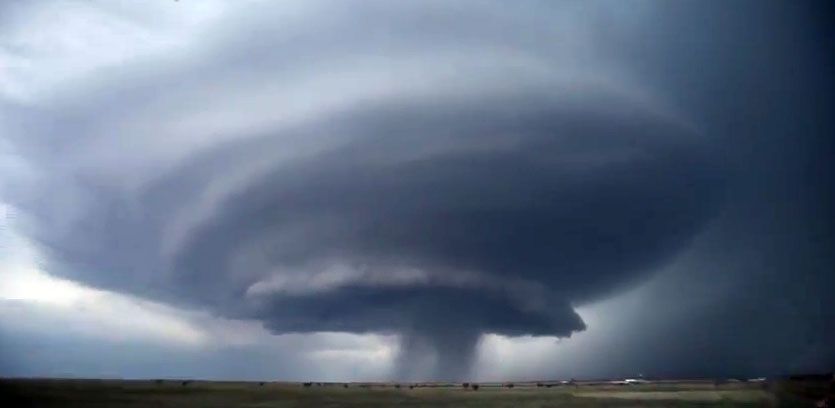Spectacular Texas Thundercloud Caught on Video

An ominous cloud formation that developed in the Texas panhandle last week looks like a CGI effect straight out of a summer blockbuster. This tornadic thunderstorm, which formed near the town of Adrian during the evening of May 21 and gave rise to at least one twister, offered passersby with video cameras an exceptional view of nature's might.
Experts say the saucer-shaped cloud was the most severe type of thunderstorm: a supercell. "What you are seeing here is a well-developed rotating supercell thunderstorm, and the condensation pattern at cloud base forms a 'belt' or 'wall' appearance as air is lifted and sucked into the swirling storm," said Chris Walcek, a meteorologist at the Atmospheric Sciences Research Center at the State University of New York, Albany.
Supercells form when a pocket of hot, vapor-filled air starts to rise in the presence of just the right amount of "wind shear," or change in wind speed with height. The huge air pocket starts to rotate, and the Coreolis force generated by the spin of the Earth enhances the air pocket's rotation. [Astonishing Video Shows a Face in the Clouds]
Judging by the clear view the filmographers have of their subject, this particular storm is most likely a "low precipitation (LP) supercell," said Bill Cotton, professor emeritus of meteorology at Colorado State University and an expert on cloud and storm dynamics. These typically produce little rain, but lots of hail, and while the process is not totally understood by scientists, "I might speculate that the storm is ingesting large amounts of pollution or dust, which would suppress the warm rain process and result in the prevalence of hail," Cotton told Life's Little Mysteries.
These relatively dry supercells are storm-chasers' favorite variety of tornadic thunderstorm, because the lack of view-obscuring rainfall means tornadoes and other impressive cloud features can be seen from a safe distance. Walcek said, "There is [usually] so much rain falling from these storms that the cloud formations are hidden behind sheets of falling rain."
This story was provided by Life's Little Mysteries, a sister site to LiveScience. Follow Natalie Wolchover on Twitter @nattyover. Follow Life's Little Mysteries on Twitter @llmysteries, then join us on Facebook.
Sign up for the Live Science daily newsletter now
Get the world’s most fascinating discoveries delivered straight to your inbox.
Natalie Wolchover was a staff writer for Live Science from 2010 to 2012 and is currently a senior physics writer and editor for Quanta Magazine. She holds a bachelor's degree in physics from Tufts University and has studied physics at the University of California, Berkeley. Along with the staff of Quanta, Wolchover won the 2022 Pulitzer Prize for explanatory writing for her work on the building of the James Webb Space Telescope. Her work has also appeared in the The Best American Science and Nature Writing and The Best Writing on Mathematics, Nature, The New Yorker and Popular Science. She was the 2016 winner of the Evert Clark/Seth Payne Award, an annual prize for young science journalists, as well as the winner of the 2017 Science Communication Award for the American Institute of Physics.












